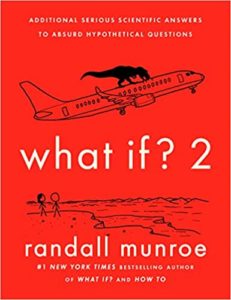What If?, this book’s predecessor, hit the sweet spot of serious science mixed up with deadpan presentation, and proved a (periodically dangerous) garden of delights. The second book exploring “serious scientific answers to absurd hypothetical questions” does just that, boggling and amusing in nearly equal measure. If the leitmotif of the first volume is “What if we tried more power?” the two of this one are creating black holes and eradicating all life on Earth. For a book with as many apocalypses as this one, though, it’s very cheerful, probably because practically all of them can be avoided by just not doing extremely silly things. Or at least hoping that geological disasters from Earth’s past don’t repeat anytime soon.
For example, in one of the short answer sections, reader Ian asks what would happen if Mount Everest suddenly turned into pure lava. Not to worry, says Monroe, even though Everest is large for an individual human, it’s small on the scale of the earth and outside of the local area, life would be undisturbed. Monroe’s reassurance, though, is limited. Much larger lava events — up to three orders of magnitude larger than an Everest of lava — have happened in Earth’s history, and
These outpourings, which create massive rock slabs called “large igneous provinces,” are bad news for life. There are five big mass extinctions in the fossil record, and all five of them were accompanied by large amounts of lava blorping onto the surface.
Eyes first evolved about half a billion years ago, and in that time, the Permian extinction is probably the worst thing they’ve seen. A large eruption of lava in what is now Siberia injected huge amounts of CO2 into the atmosphere, causing temperatures to spike. The oceans deoxygenated and acidified. Clouds of poison gas rolled across the land. Most plant life was wiped from the continents, leaving Earth a sandy desolate wasteland. Almost everything died. (pp. 138–39)
Fortunately for humanity, large igneous provinces seem to form over geologic time scales.
Other questions that don’t even make into the “Weird and Worrying” category yield much more catastrophic results. “What would happen if the Earth’s rotation were sped up until a day only lasted one second?” asks reader Dylan. I know I’ve been surprised by some of the orbital speeds attributed to some exoplanets, so I found this an interesting question, not necessarily far-fetched in astronomical terms. Which goes to show that I didn’t do any math. What would happen?
The equator would be moving at over 10 percent of the speed of light. Centrifugal force would become much more stronger than gravity, and the material that makes up the Earth would be flung outward. …
The Earth’s crust and mantle would break apart into building-size chunks. …
In the first few seconds, the expansion would shatter the crust into spinning fragments and kill just about everyone on the planet, but that’s relatively peaceful compared to what would happen next. (pp. 108–09)
Monroe explains a few more things that would happen as the remains of the Earth spread throughout the Solar System. And if the Moon had happened to be crossing the plane of the Earth’s equator, the impact of the Earth bits “would turn the Moon into a comet, rocketing out of the Solar System on a wave of high-energy debris.” (p. 110) Boom.
More optimistically, it turns out that standard swing sets are very nearly optimal in terms of how high a person can go just by pumping their legs. (pp. 78–82) All the world’s bananas can fit inside all the world’s churches. (pp. 52–54) You could drink the water in a smallish cloud all at one go, and while it wouldn’t be comfortable, it wouldn’t be deadly either. (pp. 195–198) Monroe spends 11 pages (287 through 297) answering a five-year-old’s question about how long it would take to slide down a fireman’s pole all the way from the Moon to the Earth. The answer is years, because you’d first have to climb out of the Moon’s gravity well. Then by the end you’d be sliding entirely too fast, to say nothing of the winds.
What If? 2 shows the joy of taking silly things seriously, and learning about how to apply math and known laws of science to even the most absurd situations. It was a joy to read in large chunks, and it’s fun to dip back into. What could possibly go wrong?

